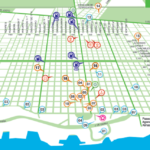
Technical tour to La Plata Green Belt
Programme | 24/10/2024
| 7:00 | Transfer from Ciudad Autónoma de Buenos Aires to La Plata Green Belt (La Plata) |
| 8:00-12:00 | Visit to Horticultural and Floricultural Growers |
| 12:00 | Transfer to AEP (Jorge Newbery Airport) (Ciudad Autónoma de Buenos Aires) |
Technical tour to the Argentine Northwest
Programme | 24-25/10/2024
24/10/2024 Transfer from Salta or Perico (Jujuy Airport) to Libertador Gral. San Martín (Jujuy): Overnight in Libertador Gral. San Martin (Jujuy)
| 25/10/2024 | |
| 7:00 | Transfer to Colonia Santa Rosa (Salta) |
| 8:30-12:00 | Visit to Colonia Santa Rosa |
| Transfer to INTA Yuto (Jujuy) | |
| 13:00-13:30 | Arrival and reception in INTA Yuto |
| 13:30-14:30 | Lunch |
| 14:30-16:00 | Visit to the INTA Yuto Experiment Station and biofumigation and/or biosolarization trials |
| 16:00 | Transfer to Libertador General San Martín to Salta or Jujuy airport (AEP)* |
| *according to the number of participants | |
Subtitling in different languages is available in the Youtube settings and is activated by placing the mouse on the lower right edge.
Prices*
*(Prices may be subject to changes)
Overnight in Ciudad Autónoma de Buenos Aires (23/10/2024)
| Transfer from San Pedro to Ciudad Autónoma de Buenos Aires | 10 USD |
| Hotel Buenos Aires (1 night) | 25 USD |
| Tango Show | 70-120 USD |
Technical Tour La Plata Green Belt (24/10/2024)
| Transfer from Ciudad Autónoma de Buenos Aires (center) to La Plata (Round trip to AEP (Jorge Newbery Airport) | 25 USD |
| Coffee break and lunch | 50 USD |
Technical Tour to Argentina Northwest (25/10/2024)
| Transfer from Ciudad Autónoma de Buenos Aires (center) to AEP | 5 USD |
| Round trip flight to NOA | 500 USD |
| Technical tour (includes transfer from and to the airport (Jujuy or Salta)) | 95 USD |
| Hotel Libertador General San Martin (1 night) | 80 USD |
| Coffee Break and lunch | 50 USD |
Touristic information
Quebrada de Humahuaca
The Quebrada de Humahuaca is an Andean valley 155 kilometers long, flanked by high mountain ranges and laboriously dug by the Grande River, located over 2000 meters above sea level. It is an arid area of scenic beauty and rich in cultural heritage, which is evident in the towns from south to north: Barcena, Volcán, Purmamarca -where Seven Colors Hill stands out, Maimará, Tilcara -where the Pucará of the same name is located-, Perchel, Huacalera, Uquía, Humahuaca and Tres Cruces. The towns in this valley link history and traditions of ancestral roots. It is a unique cultural landscape in the world, since the Indian villages of the area preserve religious beliefs, rites, festivities, art, music and agricultural techniques that are a living heritage, an important reason why it was declared a World Cultural Heritage Site by UNESCO in 2003. Its current inhabitants are mostly of the Quechua ethnic group. The valley was scene of different ancestral cultures 10,000 years ago, among them the “Omaguacas”, who gave their name to the place. In the Quebrada de Humahuaca, there are still Quechua descendants of the ancient settlers, and live in coexistence with nature, the Pachamama (Mother Earth), the Sun God, the god of thunder, lightning and all living beings whom they respect.

Iruya – Maimara | Photos: Natalia Meneguzzi
Subtropical Ecoregion – Yungas Jujeñas
Within the plurality of landscapes of Jujuy and almost overshadowed by the beauties of the Quebrada de Humahuaca forged on mountain ranges of green overflowing life are “Las Yungas Jujeñas”. The Calilegua National Park is the beginning of the trails to the sky, a protected natural area and Biosphere Reserve of 1.3 million hectares of jungle, forest, pastures and crops. We start our trip from Libertador General San Martin (120 km from San Salvador), Ledesma, recognized worldwide for its famous sugar mill. You can spend the night to acclimatize and start climbing up to the Valleys.

Yungas | Photos: Santiago Bonillo
Cachi-Cafayate. Wine Route
The Wine Route in Salta, a captivating destination, where the flavor of the land and the landscapes of the Calchaquíes Valleys merge in the same experience. These Calchaquíes Valleys have a dry and temperate climate, optimal for the cultivation and production of Torrontés (the unique native variety in the country and a grape variety very well adapted to the region) and other table wines. With a wide geographical biodiversity, the province of Salta has vineyards located between 1600 meters above sea level (5249 feet) in Cafayate to more than 2400 meters above sea level (7874 feet) in the vicinity of Molinos, which gives the wine a great character, strong personality and high quality with unique fragrances, colors and flavors. This dream route goes through places with very striking landscapes such as Quebrada de las Flechas, Quebrada de las Conchas and centenary towns such as Molinos and Cachi with an enormous cultural richness expressed in music and handicrafts. At present, vineyards extend in the province for more than 2500 ha in the departments of Cafayate, San Carlos, Angastaco and Molinos and in the towns of Cachi, Payogasta and Seclantás is where we can taste the production of artisan wines.
In recent years, the wine industry in the Province of Salta has experienced great growth and development, favoring the production of excellent high quality wines recognized in international markets and competitions, we can proudly say that they are part of the highest Wine Route in the world.

Cachi & Cafayate : Quebrada de Las Conchas (Los Castillos) (1) ) Cafayate and Vineyards in the area of Cachi and Cafayate (2) | Photos: Karen Ayala – Salta. Nevado del Cachi (3) | Photo: Jesús Dehesa (https://www.norte.com/camino-a-cachi-cornisas-y-mucho-paisaje/)




